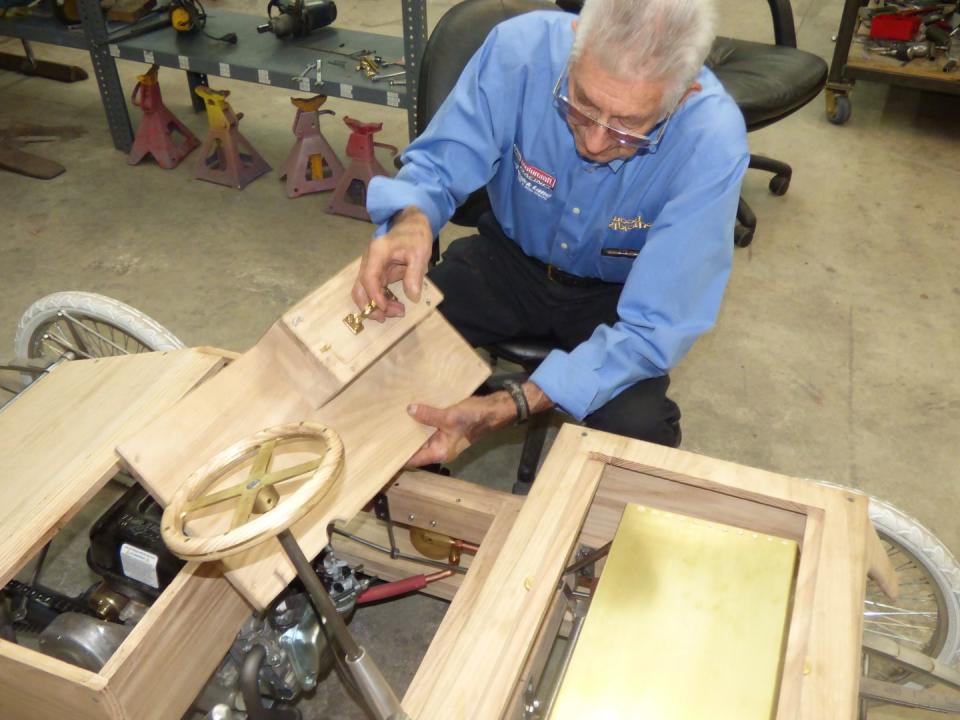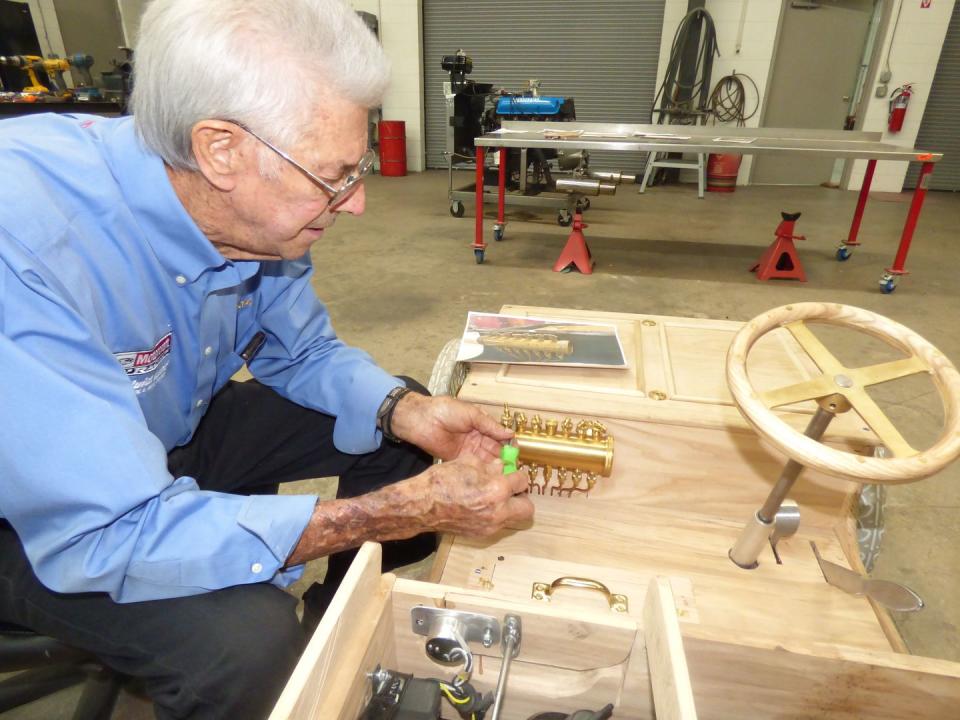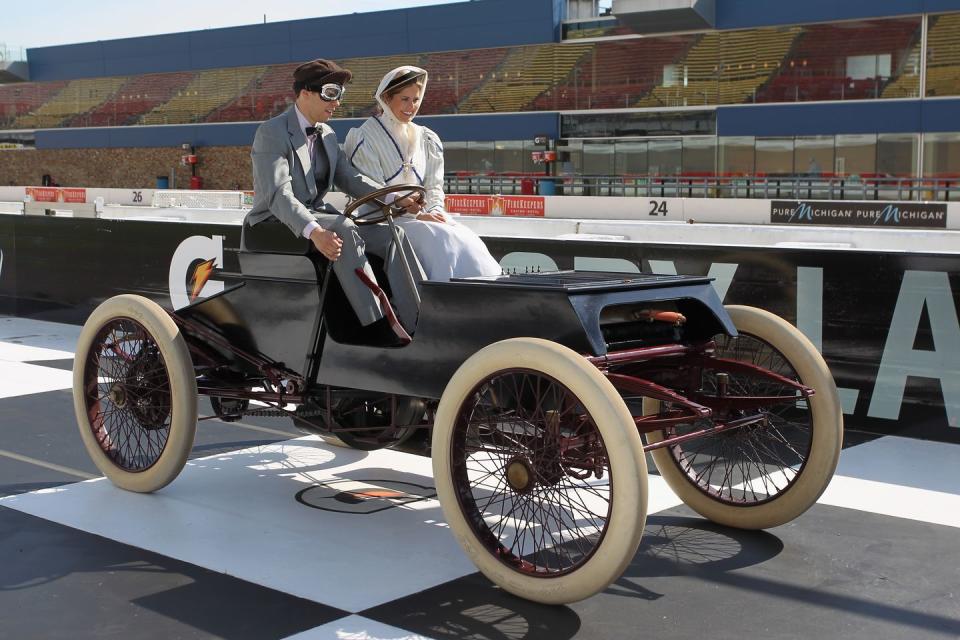NASCAR Hall of Famer Leonard Wood Driven by 'Sweepstakes' Challenge

- Oops!Something went wrong.Please try again later.
Leonard Wood is a member of the NASCAR Hall of Fame and one of the best crew chiefs and mechanics in the history of the sport.
He is completing about eight months of work on a half-scale model of Sweepstakes, the Ford race car Ford Motor Co. founder Henry Ford drove to a victory in 1901.
The original Sweepstakes has an honored spot in the Henry Ford museum in Dearborn, Michigan.
It is rare that anyone in any business or other endeavor can celebrate 80 years with that connection.
Leonard Wood is not only celebrating. He’s still working and aiming for more. The fact that he is 87 years old—he’ll be 88 in September—only makes it all the more amazing.
Wood, a member of the NASCAR Hall of Fame Class of 2013 and one of the best crew chiefs and mechanics in the history of the sport, remains a strong link in the fabric of Wood Brothers Racing, one of NASCAR’s bedrock teams. Although he gave up pit-road duties many years ago, Wood still wears the red and blue colors of the No. 21 team and works Monday through Friday in his shop at the Wood Brothers primary location in Stuart, Virginia.
People who know Wood well say he could build an engine using only a paper clip, and watching him work underlines that thought. Once a master at building powerful race engines and developing winning pit strategies, he now concentrates on building stunningly accurate scale models of race cars. A visit to the Wood Brothers Racing Museum adjacent to the shop provides convincing evidence that he is among the country’s best at this rather specialized activity.

Wood’s best work yet, however, is likely headed to a bigger stage. He is completing about eight months of work on a half-scale model of Sweepstakes, the Ford race car Ford Motor Co. founder Henry Ford drove to a victory in 1901. The model, fine-tuned to the last minor detail, likely will wind up in a place of honor somewhere in the Ford universe in or around Detroit.
Sweepstakes is a critical part of the history of the Blue Oval. Henry Ford led design and building of the car in 1901 and won a 10-mile race against Alexander Winton in the 96-inch-wheelbase car with a two-speed manual transmission. The good will and publicity from the race success encouraged investors to join Ford in his car-manufacturing business.
Sweepstakes has an honored spot in the Henry Ford museum in Dearborn, Michigan.
Wood, who was born in 1934, fell under the spell of Henry Ford’s vehicles as a child, long before he would begin the tinkering that ultimately turned into magic.
“My uncle (Penn Wood) bought a brand new 1940 Ford,” Wood said. “I thought it was the greatest thing. I’ve been a fan of Ford products all these years. I grew up loving Fords. I always thought about how great it would be to work for Ford Motor Company.”

Wood did much more than that, of course. He and his brothers ultimately built fast race cars—Fords and Mercurys—for some of the best drivers in stock car racing history. Born before NASCAR, the Wood Brothers Racing team continues today. Its next Cup victory will be its 100th.
“I have a very small model of the Sweepstakes car sitting on my dresser at home,” Wood said. “I got to thinking how rewarding it would be to make a model of the car that started it all for Henry Ford, especially since I’ve been such a fan all these years. To make a car like Henry Ford made—his first race car—like 80 years after I first learned about Ford, it’s mind-blowing.”
So is the model.
Wood is famous among the racing community for building models to exact specifications. “If you can’t build something that’s not exactly right, why do it?” he asked.
To replicate Sweepstakes at 50% of its size, Wood traveled to the Henry Ford museum last December and shot hundreds of photos of the car from every angle. He was surprised, he said, to discover that the car’s body is wooden.

Returning to Stuart, he bought boards of ash (“Stronger than oak,” he said) to produce the body of the car and molded aluminum, steel and brass to configure the pieces from front to back.
Bennie Belcher, a long-time machinist at the Woods’ shop, cut the base metal pieces for the car parts, giving Wood more time for the finer detail work.
“The hardest part was not having the car here,” Wood said. “With that, I could have just walked over and measured one-half of every piece. Instead, working with the pictures was harder—getting the right size in proportion to everything else.
“This has to be top of the line when it’s done.”
Wood compared the joy of building scale models to his former work producing winning engines for the No. 21.

“I used to design cylinder heads and headers and manifolds,” he said. “I knew going in this is the way I wanted it to work, but I know it might not. If it doesn’t work, I don’t say, ‘Poor me.’ I try it another way.
“But, boy, when it does work, when that thing pulls 20 more horsepower and sounds so crisp and keen and nice, that’s what makes it worth it.”
At 87, it’s clear that that joy still runs deep for Wood.
“I can get up and down like people half my age,” he said. “I can’t run and do what I once did, but my brain is still as good as it ever was. In fact, it seems like there are times I’ll be thinking about how to make something and something just trips my brain. That’s the way to do it. I give the good Lord the credit.”
During his “off” time at home in Stuart, Wood builds remote-control race cars. They’re better than most. They run about 70 miles per hour.
“They said my dad (John Walter Wood) was the greatest mechanic in Patrick County,” Wood said. “As a kid, I could have asked him how to do something, but I didn’t want to ask anybody. I wanted to do it myself.”


